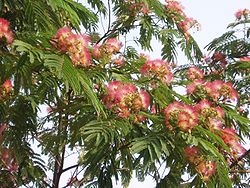Albizia julibrissin
| Albizia julibrissin subsp. var. | silk tree, mimosa, Persian silk tree, pink siris, Lenkoran acacia, bastard tamarind | |||||||||||||||||||||||||||||||||||||||||||||||||||||||
|---|---|---|---|---|---|---|---|---|---|---|---|---|---|---|---|---|---|---|---|---|---|---|---|---|---|---|---|---|---|---|---|---|---|---|---|---|---|---|---|---|---|---|---|---|---|---|---|---|---|---|---|---|---|---|---|---|

|
|
| ||||||||||||||||||||||||||||||||||||||||||||||||||||||
| ||||||||||||||||||||||||||||||||||||||||||||||||||||||||
Albizia julibrissin is a small deciduous tree growing to 5–12 m tall, with a broad crown of level or arching branches. The bark is dark greenish grey in colour and striped vertically as it gets older. The leaves are bipinnate, 20–45 cm long and 12–25 cm broad, divided into 6–12 pairs of pinnae, each with 20–30 pairs of leaflets; the leaflets are oblong, 1–1.5 cm long and 2–4 mm broad. The flowers are produced throughout the summer in dense inflorescences, the individual flowers with no petals but a tight cluster of stamens 2–3 cm long, white or pink with a white base, looking like silky threads. They have been observed to be attractive to bees, butterflies and hummingbirds. The fruit is a flat brown pod 10–20 cm long and 2–2.5 cm broad, containing several seeds inside.
Cultivation
Propagation
Seed, but the hard seat coat requires scarification before germination can occur. Nick the seed with a file, soak it in sulfuric acid, or plunge it into boiling water.
Pests and diseases
Wilt disease.
Varieties
There are two varieties:
- Albizia julibrissin var. julibrissin. The typical variety, described above.
- Albizia julibrissin var. mollis. Differs in the shoots being densely hairy.
There is also a form, Albizia julibrissin f. rosea which has, in the past, been classed either as a variety or as a cultivar. This is a smaller tree, only growing to 5–7 m tall, with the flowers always pink. Native to the northeast of the species' range in Korea and northern China, it is more cold-tolerant than the typical form, surviving temperatures down to at least -25 °C.
Gallery
If you have a photo of this plant, please upload it! Plus, there may be other photos available for you to add.
-
f. rosea
-
leaves, flowers and buds
-
f. rosea
References
- w:Albizia julibrissin. Some of the material on this page may be from Wikipedia, under the Creative Commons license.
- Albizia julibrissin QR Code (Size 50, 100, 200, 500)
External links






















